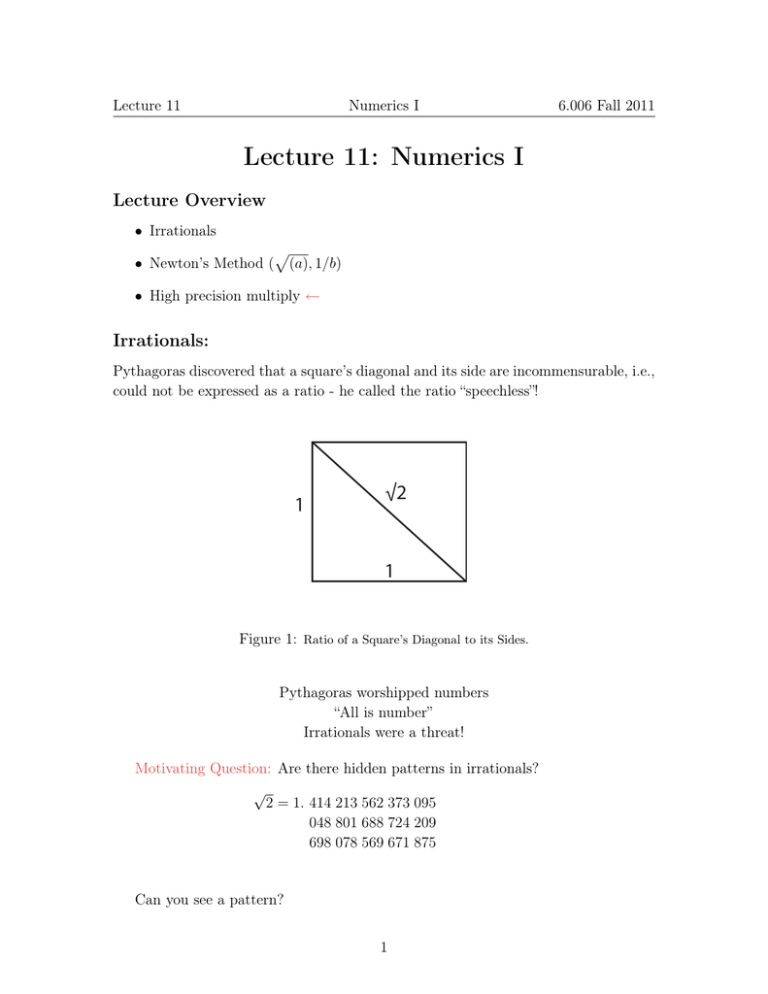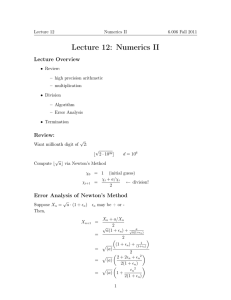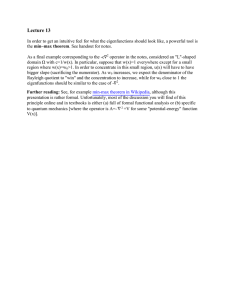Lecture 11: Numerics I Lecture Overview
advertisement

Lecture 11
Numerics I
6.006 Fall 2011
Lecture 11: Numerics I
Lecture Overview
• Irrationals
p
• Newton’s Method ( (a), 1/b)
• High precision multiply ←
Irrationals:
Pythagoras discovered that a square’s diagonal and its side are incommensurable, i.e.,
could not be expressed as a ratio - he called the ratio “speechless”!
1
√2
1
Figure 1: Ratio of a Square’s Diagonal to its Sides.
Pythagoras worshipped numbers
“All is number”
Irrationals were a threat!
Motivating Question: Are there hidden patterns in irrationals?
√
2 = 1. 414 213 562 373 095
048 801 688 724 209
698 078 569 671 875
Can you see a pattern?
1
Lecture 11
Numerics I
6.006 Fall 2011
Digression
Catalan numbers:
Set P of balanced parentheses strings are recursively defined as
• λ ∈ P
(λ is empty string)
• If α, β ∈ P , then (α)β ∈ P
Every nonempty balanced paren string can be obtained via Rule 2 from a unique α, β
pair.
For example, (()) ()() obtained by ( () ) ()()
|{z} |{z}
α
β
Enumeration
Cn : number of balanced parentheses strings with exactly n pairs of parentheses
C0 = 1 empty string
Cn+1 ? Every string with n + 1 pairs of parentheses can be obtained in a unique way
via rule 2.
One paren pair comes explicitly from the rule.
k pairs from α, n − k pairs from β
Cn+1 =
n
X
Ck · Cn−k
n≥0
k=0
C0 = 1 C1 = C0 2 = 1 C2 = C 0 C1 + C1 C0 = 2 C3 = · · · = 5
1, 1, 2, 5, 14, 42, 132, 429, 1430, 4862, 16796, 58786, 208012, 742900, 2674440,
9694845, 35357670, 129644790, 477638700, 1767263190, 6564120420, 24466267020,
91482563640, 343059613650, 1289904147324, 4861946401452, 18367353072152,
69533550916004, 263747951750360, 1002242216651368
2
Lecture 11
Numerics I
6.006 Fall 2011
Newton’s Method
Find root of f (x) = 0 through successive approximation e.g., f (x) = x2 − a
xi
xi+1
y = f(x)
Figure 2: Newton’s Method.
Tangent at (xi , f (xi )) is line y = f (xi ) + f 0 (xi ) · (x − xi ) where f 0 (xi ) is the derivative.
xi+1 = intercept on x-axis
f (xi )
xi+1 = xi − 0
f (xi )
Square Roots
f (x) = x2 − a
2
χi+1 = χi −
(χi − a)
=
2χi
χi +
a
χi
2
Example
χ0
χ1
χ2
χ3
χ4
= 1.000000000
= 1.500000000
= 1.416666666
= 1.414215686
= 1.414213562
a=2
Quadratic convergence, ] digits doubles. Of course, in order to use Newton’s method,
we need high-precision division. We’ll start with multiplication and cover division in
Lecture 12.
3
Lecture 11
Numerics I
6.006 Fall 2011
High Precision Computation
√
2 to d-digit precision: 1| .414213562373
{z
}···
√d digits
√
d
Want integer b10 2c = b 2 · 102d c - integral part of square root
Can still use Newton’s Method.
High Precision Multiplication
Multiplying two n-digit numbers (radix r = 2, 10)
0 ≤ x, y < rn
x = x1 · rn/2 + x0
y = y1 · r
n/2
+ y0
0 ≤ x0 , x1 < r
x1 = high half
x0 = low half
n/2
0 ≤ y0 , y1 < rn/2
z = x · y = x1 y1 · rn + (x0 · y1 + x1 · y0 )rn/2 + x0 · y0
=⇒ quadratic algorithm θ(n2 ) time
4 multiplications of half-sized ]’s
Karatsuba’s Method
log2n
log2n
3T(n/2)
3log n = nlog 3
4T(n/2)
log n
4 = nlog 4 = n2
2
2
2
Figure 3: Branching Factors.
4
2
Lecture 11
Numerics I
6.006 Fall 2011
Let
z0 = x0 · y0
z2 = x1 · y1
z1 = (x0 + x1 ) · (y0 + y1 ) − z0 − z2
= x0 y1 + x1 y0
z = z2 · rn + z1 · rn/2 + z0
There are three multiplies in the above calculations.
T (n) =
time to multiply two n-digit]0 s
= 3T (n/2) + θ(n)
= θ nlog2 3 = θ n1.5849625···
This is better than θ(n2 ). Python does this, and more (see Lecture 12).
Fun Geometry Problem
B
1
C
D
A
1000,000,000,000
Figure 4: Geometry Problem.
BD = 1
What is AD?
AD = AC − CD = 500, 000, 000, 000 −
s
500, 000, 000, 0002 − 1
|
{z
}
a
Let’s calculate AD to a million places. (This assumes we have high-precision division, which we will cover in Lecture 12.) Remarkably, if we evaluate the length
5
Lecture 11
Numerics I
6.006 Fall 2011
to several hundred digits of precision using Newton’s method, the Catalan numbers
come marching out! Try it at:
http://people.csail.mit.edu/devadas/numerics_demo/chord.html.
An Explanation
This was not covered in lecture and will not be on a test. Let’s start by looking at
the power series of a real-valued function Q.
Q(x) = c0 + c1 x + c2 x2 + c3 x3 + . . .
(1)
Then, by ordinary algebra, we have:
1 + xQ(x)2 = 1 + c20 x + (c0 c1 + c1 c0 )x2 + (c0 c2 + c1 c1 + c2 c0 )x3 + . . .
(2)
Now consider the equation:
Q(x) = 1 + xQ(x)2
(3)
For this equation to hold, the power series of Q(x) must equal the power series of
1 + xQ(x)2 . This happens only if all the coefficients of the two power series are equal;
that is, if:
c0 = 1
(4)
c1 = c20
(5)
c2 = c0 c1 + c1 c0
(6)
c3 = c0 c2 + c1 c1 + c2 c0
(7)
etc.
(8)
In other words, the coefficients of the function Q must be the Catalan numbers!
We can solve for Q using the quadratic equation:
Q(x) =
1±
√
1 − 4x
2x
Let’s use the negative square root. From this formula for Q, we find:
6
(9)
Lecture 11
Numerics I
6.006 Fall 2011
√
1 − 4 · 10−24
10−12 · Q(10−24 ) = 10−12 ·
−24
2 · 10√
= 500000000000 − 5000000000002 − 1
1±
(10)
(11)
From the original power-series expression for Q, we find:
10−12 · Q(10−24 ) = c0 10−12 + c1 10−36 + c2 10−60 + c3 10−84 + . . .
(12)
√
Therefore, 500000000000 − 5000000000002 − 1 should contain a Catalan number in
every twenty-fourth position, which is what we observed.
7
MIT OpenCourseWare
http://ocw.mit.edu
6.006 Introduction to Algorithms
Fall 2011
For information about citing these materials or our Terms of Use, visit: http://ocw.mit.edu/terms.


